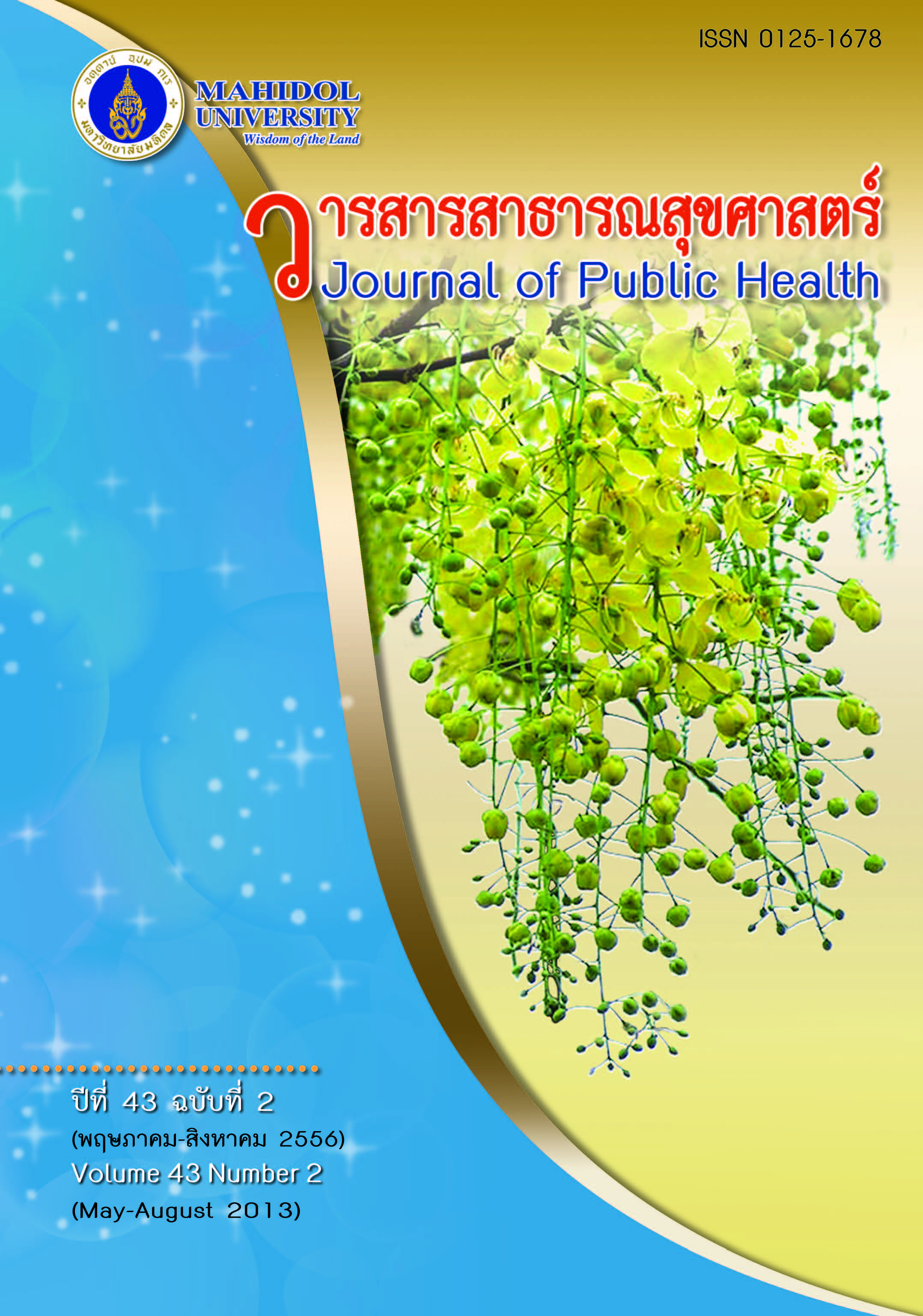ปัจจัยทำนายพฤติกรรมการตรวจคัดกรองมะเร็งปากมดลูกของสตรีในจังหวัดราชบุรี
Keywords:
มะเร็งปากมดลูก, ปัจจัยทำนาย, การตรวจคัดกรอง, cervical cancer, predicting factors, screening behaviorAbstract
บทคัดย่อ
การวิจัยเชิงพรรณนาแบบ case-control study ครั้งนี้มีวัตถุประสงค์เพื่อศึกษาปัจจัยที่มีความสัมพันธ์และสามารถร่วมกันทำนายพฤติกรรมการตรวจคัดกรองมะเร็งปากมดลูกของสตรี ดำเนินการศึกษาในสตรีอายุ 30-60 ปี ตำบลบ้านไร่ อำเภอเมือง จังหวัดราชบุรี จำนวนกลุ่มตัวอย่าง 264 คน จำแนกเป็นกลุ่มศึกษาและกลุ่มเปรียบเทียบกลุ่มละ 132 คน คัดเลือกกลุ่มตัวอย่างโดยการสุ่มตัวอย่างแบบง่าย รวบรวมข้อมูลด้วยแบบสัมภาษณ์ วิเคราะห์ข้อมูลด้วยสถิติ จำนวน ร้อยละ Adjusted Odds Ratio (95% CI) และสถิติถดถอยแบบไบนารี (Binary Logistic Regression) ผลการวิจัย พบว่า ปัจจัยที่มีความสัมพันธ์และทำนายพฤติกรรมการตรวจคัดกรองมะเร็งปากมดลูกอย่างมีนัยสำคัญทางสถิติที่ระดับความเชื่อมั่น 95% ประกอบด้วยปัจจัยส่วนบุคคล ได้แก่ รายได้ และการคุมกำเนิด ปัจจัยภายใน/ปัจจัยนำ คือ เจตคติต่อการตรวจคัดกรองมะเร็งปากมดลูก และปัจจัยแวดล้อม ได้แก่ การได้รับข้อมูลข่าวสารการตรวจคัดกรองมะเร็งปากมดลูกจากอาสาสมัครสาธารณสุขประจำหมู่บ้าน(อสม.) การมีประสบการณ์รับรู้ว่าคนใกล้ชิดหรือคนในครอบครัวหรือญาติไปรับการตรวจคัดกรองฯ สิทธิเบิกค่ารักษาพยาบาล และการตรวจสุขภาพประจำปี ซึ่งตัวแปรทั้งหมดสามารถร่วมกันทำนายพฤติกรรมการตรวจคัดกรองมะเร็งปากมดลูกของสตรีอายุ 30-60 ปี ได้ร้อยละ 52.1 โดยตัวแปรที่มีอิทธิพลมากที่สุดเรียงตามลำดับจำนวน 5 ตัวแปร คือ การตรวจสุขภาพประจำปี การได้รับข้อมูลข่าวสารจาก อสม. การคุมกำเนิดถาวร สิทธิเบิกค่ารักษาพยาบาล และการรับรู้ว่าคนใกล้ชิดหรือคนในครอบครัวหรือญาติหรือคนรู้จักไปรับการตรวจคัดกรองฯ ดังนั้น การเพิ่มอัตราการคัดกรองมะเร็งปากมดลูกของสตรีอายุ 30-60 ปี ทำได้โดยโรงพยาบาลส่งเสริมสุขภาพตำบลจัดบูรณาการตรวจคัดกรองฯกับการตรวจสุขภาพประจำปี จัดบริการนอกเวลาหรือเคลื่อนที่ไปในชุมชนสอดคล้องกับความต้องการและบริบทของพื้นที่ และจัดฝึกอบรมเพื่อพัฒนาศักยภาพ อสม.ในการสร้างจูงใจกลุ่มเป้าหมายให้มีประสิทธิภาพยิ่งขึ้น
Factors Predicting Cervical Cancer Screening Behavior among Women
in Ratchaburi Province
ABSTRACT
This case-control study aimed to examine factors related to and predicting cervical cancer screening behavior among women. A sample consisting of 264 women aged 30-60 years in Banrai Sub-district, Muang District, Ratchaburi Province was chosen and categorized into two groups, study group and comparison group, each consisting of 132 participants. The data were collected by interview form. Data analysis employed frequency, percentage, adjusted odds ratio (95% CI), and binary logistic regression analysis. The results indicated that the personal factors related to and predicting cervical cancer screening behaviors with statistical significance at 95% confidence were income and contraceptive methods. A significant internal or predisposing factor was attitude towards cervical cancer screening. Significant supporting factors were information provided to village health volunteers, perceived experience with cervical cancer screening by close friends/relatives, rights to medical care, and annual health checks. Those factors were predictive of 52.1% of cervical cancer screening behavior. The top five influential factors in descending order were annual health checks, information provided to village health volunteers, contraceptive methods, rights to medical care, and perceived experience with cervical cancer screening by close friends/relatives. These results highlight several possible ways to increase cervical cancer screening rates among women aged 30-60 years, such as integrating cervical cancer screening in annual health checks of Health Promoting Hospitals at the sub-district level, providing extra or proactive service to communities congruent with people’s needs and the community context, and providing training for village health volunteers in skills to build effective motivation.
Downloads
Issue
Section
License
Creative Commons License CC-BY-ND


